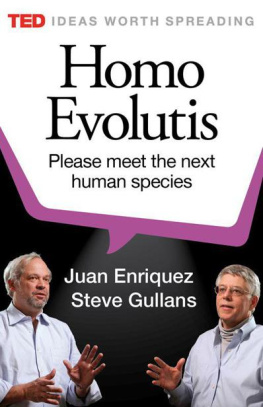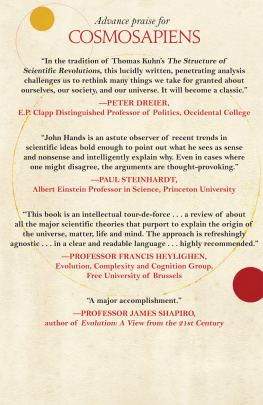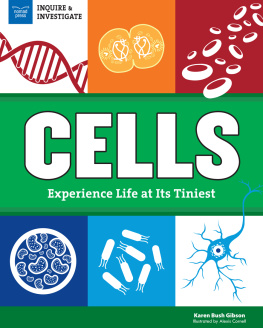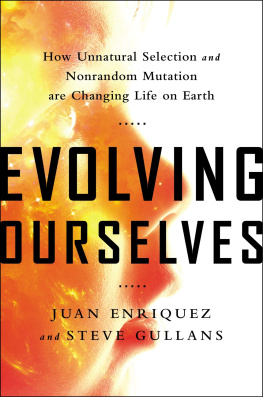TABLE OF CONTENTS
Intro: Two Theories of the Case
For better, and worse, humans have evolved
We know of at least 25 speciation events.
That is to say there have been 25 different prototypes of a humanoid species before reaching what some consider the be-all and end-all of evolution, the pinnacle of all creation
Ourselves.
But what if this grand experiment has not stopped?
What if, like every other species on the planet, we are continuing to evolve?
What would the next human species look like?
But before we get deep into exactly what this new species might look like
We might as well take on the naysayers and critics who think this talk of speciation is poppycock, kerfuffle, bull crickey, or at the very least blasphemous.
So lets start with a simple question
Are You Two Crazy?
Perfectly possible.
No one has ever thought of us, or accused us, of being conventional thinkers.
By the very nature of our careers, in academia, in venture capital, we are exposed, often years before much of the public, to some of the most outlandish, and most powerful, technologies known.
We meet inventors and pioneers in fields like cell programming, brain mapping, robotics, computing, nanotechnology, electronics, tissue engineering, genomics, proteomics, metabolomics, epigenomics, metagenomics and dozens of other omics that have yet to appear in any conventional spellchecking dictionary.
To successfully fund high tech research and turn it into a marketable product and a successful company, you must have a very high tolerance for strange ideas, new concepts, risk, and extreme ways of doing things.
We also need to understand what is short-term practical.
(And yes, sometimes what sounds like science fiction, is actually real.)
So let us stress
This book is not intended to be a work of science fiction.
It is based on science fact.
We are not futurists; what we are doing is closer to history and cartography.
We focus on discoveries that have already occurred, usually very recently, on how they profoundly change tomorrow.
Bringing together many loosely connected pieces and trends can provide a pretty good glimpse and a rudimentary map, of what is coming
A new human species.
(But shhh dont tell anyone or they, too, will think you are crazy)
Because we understand there will be many detractors and skeptics...
(And some will be most upset by what we have to say)
Let us first provide an alternate explanation
Why We Might be Wrong...
Here is one alternative theory of the case
Review a very rough draft of what we today believe is the history of the universe
It was created from a single point source in an explosion of unimaginable violence about 14 billion years ago.
Physicists now think they know what happened within the first seconds, centuries, and millennia of this explosion.
Plasma spread and began to form enormous clouds of dust.
A few clumps of dust reached critical mass then...
Immense quantities of dust began to compress and compact.
Eventually the pressure reached such extremes that atoms began to fuse.
And this in turn ignited thermonuclear reactions
Birthing stars.
(Want a more nerdly explanation? The first stars in the universe form when chemically pristine gas heats as it falls into dark-matter potential wells, cools radiatively because of the formation of molecular hydrogen, and becomes self-gravitating.)
Billions of new stars formed galaxies in wondrous shapes and sizes.
We live in the Milky Way, a relatively ancient galaxy.
(Order of magnitude check: it would take you about 50 years to count from one to a billion if you worked at it 10 hours per day.)
Within our galaxy lie 200-400 billion stars.
(A mere 200 billion star differential, even within our own galaxy, gives you a small sense of how ignorant we still are. Astronomers currently estimate there are 80 billion galaxies containing 30-70 sextillion stars and yes, sextillion really is a number.)
Within the possibly billions of planets and moons in our galaxy, lies our Sun.
Our Sun is a relative newcomer, a mere 4.57 billion years old tike.
Up til a century ago, scientists thought the Sun was much younger because at the extreme temperatures inside a star all known matter would burn up in just a few thousand years. Therefore, the universe could not be very old if all the stars were still burning. Then the Curies and others discovered radioactive elements and yet another nail went in the coffin of the 7,000 year old universe.
(But neither that discovery, nor mountains of fossils, seems to deter hoards of ignoramuses from yet again attempting to shackle school boards with ignorance.)
So our hood is nothing special.
(And in September 2010, for the first time, NASA announced the discovery of an earth like planet. The first of many, many more to come)
Billions of stars, even within our own galaxy, are hundreds or thousands of times larger than our measly Sun...
Soon after a star is born, the dust and chunks of rock left floating around begin to collapse into a few planets.
Including a tiny planet called Earth, formed about 4.5 billion years ago.
And just to reiterate the obvious, but oft forgotten
For more than 2/3 of the universes history there was no Earth.
Relatively soon after Earth was created, it was crawling with life.
Current estimates are that life appeared at least 4.5 billion years ago.
(And as we scour the fossil record creation will likely be pushed back further and further)
Then almost all life went through at least five major cycles of extinction.
The
Talk about extreme Spring cleaning
(Japans sacred gingko tree is one of the few plants that survived that extinction.)
It was only after the last major extinction, the Cretaceous-Tertiary , that mammals, and then humanoids, very gradually began to spread.
(About 0.006 billion years ago.)
To put this in context
99.96% of the entire history of the universe
took place before the first hominids,
never mind the first humans,
showed their ugly mugs.
Then, after the rise and fall of at least 25 proto humanoids, we, the Homo sapiens , somehow escaped almost certain extinction, survived, and thrived.
Now perhaps, in this overall context, some might argue that we, the self-named Homo sapiens , are the be all and end all of evolution.
In other words, the entire reason and purpose of the past 14 billion years of the known universe...
And the sole purpose of 4.5 billion years of Earths history...
And the sole purpose of 4 billion years of lifes evolution...
And five cycles of extinction
Is to create the likes of us.
And, in fact, most dominant religions preach this as
Gospel truth.
So in this theory of the case
We are the only humanoid standing because












